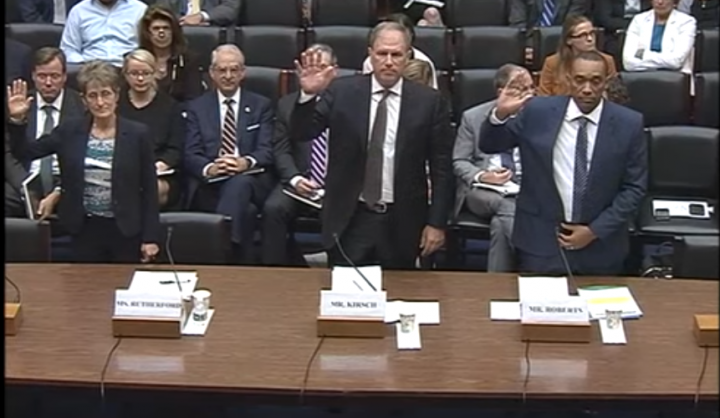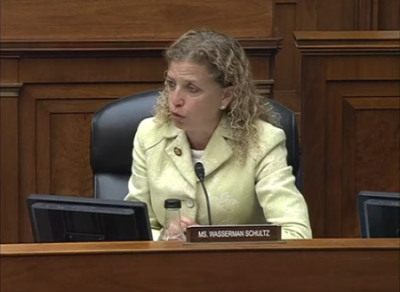
This story was reprinted from North Carolina Health News
WASHINGTON, D.C. — Near the end of a congressional hearing Sept. 10, Congresswoman Debbie Wasserman Schultz grilled executives of the 3M, DuPont and Chemours chemical companies about their willingness to compensate people harmed by fluorinated compounds.
Supporter Spotlight
The hearing, before a U.S. House subcommittee on environmental oversight and reform, was the third in a series amid pending legislation that aims to better regulate the chemicals, known collectively as per- and polyfluoroalkyl substances or PFAS, nicknamed “forever chemicals” because of their persistence in the environment.
At the core of the hearings is whether the companies should share in the costs of the cleanup of PFAS contamination across the country, as well as the costs of adverse health effects caused by them.
According to the advocacy organization, the Environmental Working Group, PFAS contamination has been found in tap water for 19 million Americans in 43 states. North Carolina is said to have the third-worst PFAS pollution problems in the country. Affected areas include the Cape Fear, Deep and Haw rivers, Jordan Lake and areas surrounding Chemours’ Fayetteville Works plant in Bladen County.
The U.S. Environmental Protection Agency has detected PFAS in 20 public water systems in 11 of the state’s counties, according to the National Institute of Environmental Health Sciences. Researchers from a consortium of North Carolina universities are now testing every municipal water system in the state for PFAS.
The contamination has been detected across the country in food, water, soil and air and at military bases and airports, where firefighting foam containing PFAS has been widely used for decades for training exercises.
Supporter Spotlight
Not taking no for an answer
The more than three-hour hearing provided insight into the companies’ willingness to take responsibility for the contamination. The following exchange between Wasserman Schultz, a Democrat from Florida, and Daryl Roberts, DuPont’s chief operations and engineering officer, was particularly illuminating:
Wasserman Schultz: “Are any of your companies that were responsible for using any of these chemicals that firefighters and military service members were exposed to planning any type of compensation to harmed victims?”
Roberts: “At this point, the DuPont Company is focused on cleaning up and remediating the sites we operate. That’s our focus, as well as reducing the amount of firefighting foam that we use on our sites, but that’s the limit of where we are focused at this time.”
Wasserman Schultz: “So no.”
Roberts: “We are focused on what … (interrupted by Wasserman Schultz)
Wasserman Schultz: “Yes or no.”
Roberts: “We will continue to focus on what’s within our control.”
Wasserman Schultz: “That’s not a yes or no answer. Yes or no, are you planning at any point on compensating people who have been harmed by your company’s chemicals?”
Roberts: “Congresswoman, are you speaking specifically about armed forces around the world?”
Wasserman Schultz: I’m speaking to this issue specifically.”
Roberts: “We are focused on working through … (interrupted again)
Wasserman Schultz: “OK, the other two people if you could answer please … Let the record reflect that the gentleman (Roberts) essentially said no, there are no plans.”
The other executives
Paul Kirsch, president of fluoroproducts for Chemours, replied “no” to Wasserman Schultz’s question as well. He also said his company has had no involvement with the two PFAS legacy compounds, PFOA and PFOS, which are found in firefighting foam and had routinely been used in everyday products such as Teflon, food packaging and water-resistant clothing.
Chemours spun off from DuPont in 2015. Chemours is a leading producer of GenX, a chemical cousin of PFOA, which DuPont had made at the Fayetteville Works plant from 2002 until voluntarily agreeing with the EPA to phase out its use around 2009 for environmental and health reasons.

GenX and thousands of other fluorinated compounds took the place of GenX and PFOA.
Chemours was found in 2017 to have contaminated drinking water with GenX for an estimated 250,000 people in New Hanover, Brunswick and Pender counties who draw their water from the Cape Fear River downriver of the plant. The state considers levels of GenX and other PFAS found in the river today to be safe to drink, but scientists continue to study the health effects of the unregulated chemicals.
Responding to Wasserman Schultz’s question, Denise Rutherford, 3M’s senior vice president of corporate affairs, said 3M has no plans to compensate people because there is no scientific evidence proving that PFOA or PFOS have caused anyone adverse health effects, a statement she repeated throughout the hearing.
Decades of denial
Before that exchange, lawyer Rob Bilott and former Minnesota Attorney General Lori Swanson outlined information contained in internal documents obtained through litigation of DuPont and 3M. The documents indicate the companies knew the dangers of PFOA and PFOS decades ago and covered them up.
Swanson and Bilott, a lawyer with Taft Stettinius & Hollister in Cincinnati, said they seriously doubt the companies would have taken responsibility for cleaning up contaminated sites near their plants in Minnesota and West Virginia if it had not been for years of litigation that resulted in multi-million dollar settlements.
Bilott has spent 20 years fighting DuPont over PFOA contamination surrounding its plant in Parkersburg, West Virginia. In 2017, Chemours and DuPont agreed to settle a class-action lawsuit filed by Bilott for $671 million.
As part of that lawsuit, Bilott formed a science panel that concluded PFOA is likely to cause kidney and testicular cancer, ulcerative colitis, preeclampsia, thyroid disease and high cholesterol.
Bilott told the congressional committee that DuPont knew for decades about the health hazards of PFOA and “acted with conscious disregard.”
3M denies human harm
Minnesota sued 3M over drinking water contamination and environmental damage in 2010. The state won an $850 million settlement last year. The money will be earmarked for cleanup, Swanson said.
Despite that settlement, and the internal 3M documents, Rutherford, a company vice president, maintained that there is no concrete scientific evidence showing that PFOA and PFOS cause adverse human health effects. She said 3M scientists have studied company workers with much higher exposure to the compounds and found no related health problems.
“The weight of scientific evidence has not established that PFOS, PFOA or other PFAS cause adverse human health effects,” Rutherford told the committee. “Public health agencies and independent science review panels, while acknowledging certain possible associations, agree with that basic fact.”
Kirsch, the Chemours executive, blamed DuPont for the contamination it created and for not assuming much more of the liability and legal costs when Chemours was spun off of DuPont four years ago.
“DuPont unilaterally designed the transaction, including a deliberate, disproportionate assignment of two-thirds of DuPont’s environmental liability and 90 percent of DuPont’s active litigation to Chemours — liability and litigation resulting from DuPont’s operating practices at dozens of manufacturing sites throughout DuPont’s very long history,” Kirsch said.
Kirsch said Chemours has entered into a consent order with North Carolina and the environmental group Cape Fear River Watch to clean up the contamination. He pointed out the company is spending $200 million on cleanup efforts and cutting emissions of GenX by 99 percent at its Fayetteville Works plant. He said costs are expected to soar “way north” of the $200 million figure as the company works to contain contamination at all of its plants.
“Collaboration and transparency are critical to addressing this issue,” Kirsch said.
Near the end of the hearing, committee Chairman Harley Rouda, a Democrat from California, questioned what he called a 123% financial increase in Chemours’ lobbying budget. Kirsch replied that he did not have knowledge of that budget.
Chemours sues DuPont
Chemours filed a lawsuit against DuPont in May of this year, saying DuPont grossly underestimated its environmental liabilities.
Roberts, the DuPont executive, countered by telling the committee that Chemours’ leadership is essentially former Dupont executives who knew, or should have known, the liabilities when the company was formed.
Roberts said Dupont did not try to reduce its liabilities, a statement Rouda later in the hearing called “patently false.”
Rouda praised Roberts when the executive said DuPont supports a proposal to designate PFOA and PFOS as hazardous substances under the Superfund law, which could help speed cleanup efforts. Those two legacy compounds have eight carbon chains, making them chemically tenacious, meaning they don’t break down in the environment easily. They’ve also been found to accumulate in the blood of humans and animals.
GenX, like most of an estimated 5,000 other types of PFAS, have shorter carbon chains. Although little is known about their human health effects, the shorter chains replaced the legacy compounds because they were thought to be more likely to break down and therefore safer. Scientists are now studying whether that is the case and whether PFAS should be regulated as a class or as subclasses.
Superfund law
Kirsch and Rutherford said any decision on whether to designate PFOA and PFOS as hazardous substances should be left up to the EPA.
Wasserman Schultz said the Department of Defense has been slow to react to PFAS contamination at military bases because the compounds are not regulated. She said this has risked the health of thousands of service members and their families.
At the end of the hearing, she made a reference to Emily Donovan, an environmental activist from North Carolina’s Brunswick County who at a July committee hearing said all PFAS compounds should be designated hazardous substances and added to the Superfund law.
“I agree with Ms. Donovan,” Wasserman Schultz said before polling the company executives as to whether they think so, too.
DuPont’s Roberts agreed to the designation, but only for PFOA and PFOS and not all PFAS. He said earlier in the hearing that DuPont would support the designation for about 22 other types of long-chain PFAS. Kirsch, from Chemours, didn’t provide a direct answer. 3M executive Rutherford said no.
“For those of you who have disagreed or refused to answer, you are playing a part in this national emergency,” Wasserman Schultz said. “You have sickened our first responders and our members of the military, and I don’t know how you sleep at night.”
This story is provided courtesy of North Carolina Health News, a website covering health and environmental news in North Carolina. Coastal Review Online is partnering with North Carolina Health News to provide readers with more environmental and lifestyle stories of interest about our coast.








